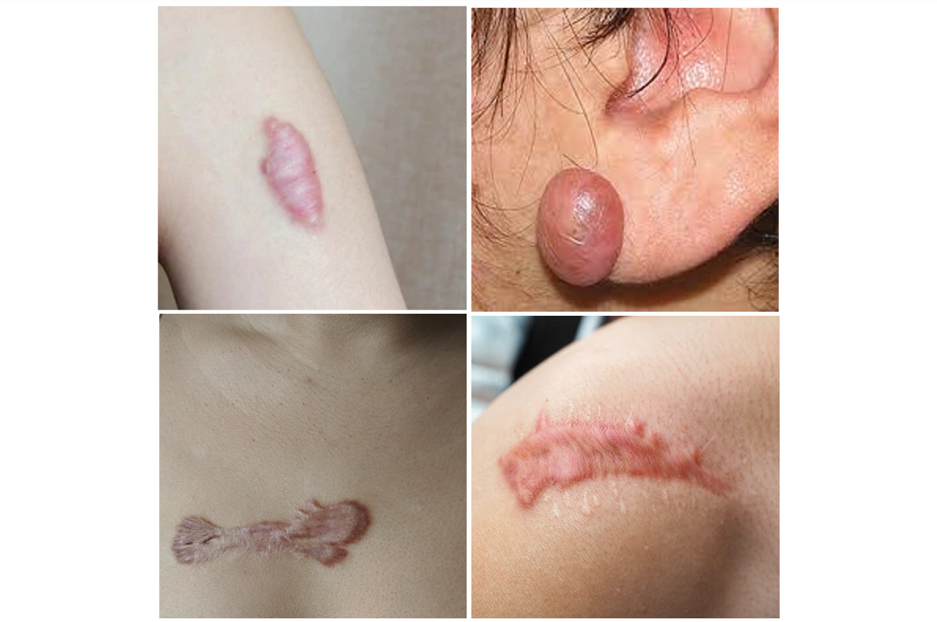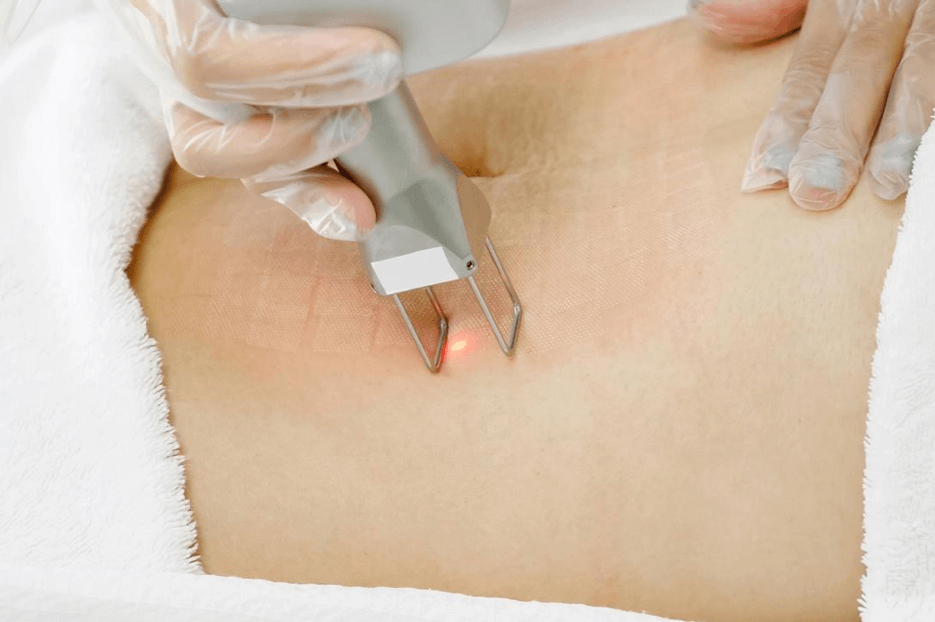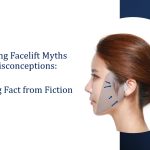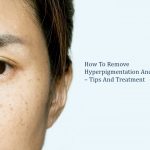What Are Keloid Acne Scars?
Keloid Acne Scar is a raised, enlarged scar that is pink, red, skin-colored, or darker than the outer skin. These scars can form due to minor skin injuries, such as an acne lesion and expand beyond the original location of skin damage. They can develop in anyone. But they are more prevalent in those with a dark complexion, such as Africans, African-Caribbean, and South Indian populations.
Keloids acne scars develop due to an accumulation of collagen and scar tissue during healing. The appearance of these scars is not only disfiguring, but it can also cause discomfort and irritation. They may get infected or even ulcerate. Keloids are most common in the ears, chest, shoulders, and upper arms. They can appear months to a year after an injury and do not resolve without treatment.

A keloid acne scar is not harmful to your health, but it can cause emotional distress. Early detection and treatment are crucial. If you are uncomfortable with how a keloid scar looks or feels, talk to your doctor about having it flattened or removed. They can remain for years or reoccur without therapy.
What Causes Keloid Acne Scars?
These are most likely a defect in the wound-healing process. Collagen, a protein present all through the body, helps in wound healing, but keloid acne scars can form when the body makes too much collagen.
Injections, body piercings, burning, hair removal, and even minor scrapes and bruises are all possible causes of keloids. They may develop for no apparent cause too. Keloids are neither contagious nor malignant.
Keloid scars may have a hereditary component, which indicates that if one or both of your parents have them, you are more likely to have them. According to one research, the AHNAK gene may be responsible for determining who gets keloid acne scars and who does not. Researchers discovered that persons who carry the AHNAK gene are more prone than others to get keloids.
Keloid Acne Scars affect around 10% of the population. They are more common among people with darker skin tones. They affect both men and women equally.
You are more prone to get keloid acne scars if you:
- Have previously had a keloid formation
- Have darkly colored skin – African, Asian, and Hispanic persons are 15% more prone to develop keloid acne scars.
- Are between 10 and 30
- Have had mesh skin grafts, which is a form of surgery used to transplant a portion of healthy skin from one place of the body to another
How to Identify Keloid Acne Scars?
Keloid acne scars are typically bigger than the original wound, thick or lumpy, and rise above the surrounding skin.
Keloid Acne Scars can be:
- Raised and hyperpigmented
- Pink, red, or purple
- Gradually expanding
- Pale and bouncy
- Itchy and painful
They can also have:
- A shining appearance
- A lack of hair on the scar
- A firm and rubbery feel to the scar
- The red or purple color at first, then transforms to a brown or pale color
- A dome-like or asymmetrical shape
When a surgical cut or injury causes keloid formation, the keloid scar tissue may continue to grow after the wound has healed. It may become larger and more noticeable until it reaches its full size.
Keloid vs. Hypertrophic Scars:

The differences between keloid and hypertrophic scars include:
Size
The size of a keloid scar can range from less than an inch to 12 inches or above. Hypertrophic scars are often smaller in size than keloid scars.
Color
Keloid is a raised, enlarged scar that can be pink, red, skin-colored, or darker than the outer skin. Hypertrophic scars are often pink, crimson, or purple.
Causes
Any type of skin injury can cause keloid development. Keloid scars are produced by excessive collagen formation. Hypertrophic scars often develop 4 to 8 weeks after a wound infection, wound closure with excessive tension, or other severe skin damage.
Growth
A hypertrophic scar grows inside the borders of the cut, but a keloid scar grows beyond the cut line itself.
Areas Of Emergence
Keloid scars are most prevalent on the upper chest, shoulders, head (particularly the earlobes after piercing), and neck, although they can appear everywhere. Hypertrophic scars are more prevalent in the back, chest, shoulders, upper arms, elbows, and other joints.
Are Keloid Acne Scars Avoidable?
Although keloids cannot be avoided, it is crucial to try to avoid skin injuries that may result in them. After an injury, applying pressure pads or silicone gel pads may help avoid keloids. Sunlight or tanning may discolor the scar tissue, making it darker than the surrounding skin. This might make the keloid more visible. To avoid discoloration, keep the scar protected when out in the sun.
Keep the wound clean and moist. Wash the affected area gently with water and mild soap. Apply a thin coating of petrolatum jelly or other ointments to the affected area. Reapply the ointment as needed throughout the day. While a wound is healing, your doctor may advise you to use a pressure pad or a silicone gel pad. Adults must take these precautions for six months following a skin injury, and children for up to 18 months to avoid keloid scars.
Can I Flatten Keloid Acne Scars With Home Remedies?
Keloids usually do not require treatment. However, if a scar causes discomfort or restricts movement, treatment may be beneficial (if it covers a joint or a large area, for example). People may seek treatment if the scar affects their self-esteem or how they feel about their looks. There are no proven methods of removing keloid scars naturally. But there are some studies that suggest using a few over-the-counter treatments and home remedies for keloids. Among the over-the-counter treatments and home remedies for keloid acne scars are:
Silicone Gel
For keloids, topical silicone gel is a safe and efficient treatment. It is simple to apply and looks good on the skin. The gel can help to hide discolored or elevated scars, as well as scars that have been there for years. It is administered directly to the scars. Make sure you follow the instructions on the product label.
Retinoid Cream
Retinoid creams, which are commonly used to treat acne and aging, work by increasing the skin’s natural cell regeneration. As a result, retinoid creams may benefit in the reduction of the size and look of keloid scars. It is directly applied to them. Follow the instructions on the retinoid cream product label.
Garlic
Garlic inhibits specific enzymes that lead to tissue and pigment accumulation. It may help lessen keloids with time. Crush two to three fresh garlic cloves together. Apply to the keloid area and leave for 15 minutes. Apply moisturizer after washing with water. If the garlic burns your skin, stop using it or lessen the amount of time you use it.
Honey
Honey has anti-inflammatory chemicals that may aid in the reduction of keloid scars. It’s a natural alternative that doesn’t have the potentially dangerous side effects of corticosteroids or nonsteroidal anti-inflammatory medicines (NSAIDs) like aspirin.
Apply a little amount of raw honey — organic honey is preferred — to the area. Allow it to settle. If the area becomes sticky, rinse it afterward. Apply as frequently as necessary. It is important to use it at least two to three times each day until you get the desired results.
Onion Extract
Onion extract helps prevent fibroblasts, the cells that generate scar tissue, from entering the skin. It decreases pigmentation. This is most likely due to the presence of quercetin, a flavonol having antioxidant effects.
Cut a small onion into small pieces. It is okay to use red, white, or yellow. Squeeze out the juice with a clean towel. Apply the juice on the keloid acne scars and let it dry. Rinse. Do it a few times daily.
Centella Asiatica
Centella Asiatica is beneficial in the treatment of wounds, including infected wounds, burns, and keloid scars. Madecassoside, a triterpenoid saponin found in Centella Asiatica herbs, has unique pharmacological effects that promote wound healing and reduce keloid formation. It comes in the form of a cream that is administered directly on the scars.
Clinical Treatments To Get Rid Of Keloid Acne Scars:
There is no single treatment that is effective for all keloid scars. Doctors usually customize treatment to individuals depending on characteristics such as age and keloid type. Keloids are difficult to remove entirely, and combining treatments often yields better outcomes. As a result, doctors frequently suggest two or more forms of treatments to their patients.
Treatment options include:
Steroid Injections

CO2 Laser Therapy
To reduce discoloration and redness in mature keloids, the doctor may offer CO2 laser therapy. This treatment method is also utilized to improve uneven skin tone produced by keloids and to reduce the visibility of stretch marks.
Pulsed Dye Laser Therapy
This is an efficient way for decreasing scar redness and discoloration. The pulsed dye laser therapy targets the scarred regions with a highly focused beam of light.
Laser therapy may be painful for some people, but a topical anesthetic cream can be used to alleviate the discomfort. Based on the severity of your condition, your doctor will advise you about the number of sessions you should attend.
Cryotherapy
Cryotherapy, often known as cryo-surgery, is the use of extremely cold temperatures to cure or remove keloids. Cryotherapy is the most successful, safest, cost-effective, and simple method for treating the bulkiest and thickest keloid scars. It’s effectiveness, like any other medical procedure, is entirely based on the expertise of the doctor using this method.
Keep in mind that cryotherapy is only recommended for specific types of keloid scars, and its effectiveness varies from patient and types of keloid. This approach is frequently used before or after corticosteroid injections to assist increase the effectiveness of the injections.
Radiation Therapy
Low-level X-ray radiation, used alone or in conjunction with the surgical excision of a keloid, can help decrease or reduce scar tissue. Treatments may need to be repeated. Radiation is frequently used to treat recurrent keloids or individuals who are at high risk of recurrences, such as those with marginal resections, greater spread, or undesirable locations. Radiation should begin the day after the keloid is surgically removed.
Bottom Line
Keloid acne scars result from the abnormal healing process of wounds or injuries and are different from hypertrophic scars in size, color, shape, and growth. It can be prevented by avoiding injury and taking good care of a wound if you get any.
If over-the-counter treatments do not improve your scars, consult a doctor about other treatments. Other treatments may include steroid injections, laser therapy, cryotherapy, and radiation therapy. You may need more than one treatment for the permanent removal of keloid scars.
About Dream Aesthetics and Plastic Surgery
Bespoke surgical for cosmetic or medical reasons is what Dream covers to bring out the beauty in every individual. Going beyond the aesthetics and working on physical anomalies are what we value the most in leading our patients to cherish self-improvement and confident lifestyles.
Derived from Associate Professor Vincent Yeow’s long-standing experience performing plastic surgery in Singapore, our treatment plans deliver physical remodelling in our patients’ favour. One of the notable remodellings is droopy eyelid correction. The ptosis surgery used for treatment eventually fixes drooping eyelids, improves vision and enhances appearance.
Most importantly, as a trustworthy plastic surgery and aesthetic clinic, we treasure positive and natural outcomes for each individual. We will ensure to deliver the beauty refinement of your dream without compromising your safety and privacy.







